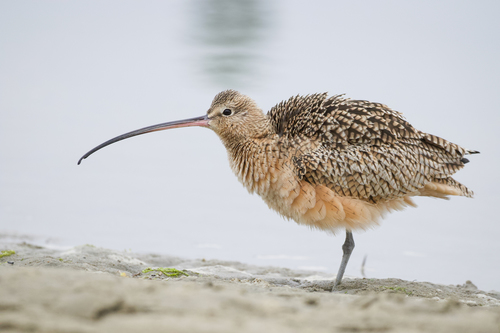
Long-billed Curlew
The Long-billed Curlew (*Numenius americanus*) is North America's largest shorebird, instantly recognizable by its exceptionally long, decurved bill. This striking feature is an adaptation for probing deep into mud and sand for invertebrates. The curlew plays a vital role in coastal and grassland ecosystems, controlling populations of crabs, worms, and insects. Historically, it held cultural significance for some Indigenous peoples, featuring in folklore and sometimes hunted for food. It is a symbol of the wild, open spaces of the American West.
50-65 cm
Length
80-100 cm
Wingspan
Least Concern
Conservation Status
Distribution
Breeds in grasslands of central and western North America, migrating south to coastal areas of the southern United States, Mexico, and Central America for the winter. Altitudinal range varies from sea level to high-elevation grasslands.
Lifespan
Up to 10 years in the wild.
Long-billed Curlew's Habitat
Habitat Types
Grasslands, Prairies, Coastal mudflats, Salt marshes, Agricultural fields (during migration and winter)
Climate Zones
Temperate, Subtropical
Adaptations
Long bill and legs are ideal for foraging in soft substrates and wading in shallow water. Specialized sensory receptors at the bill tip help detect prey buried underground.
Variations
Two subspecies are sometimes recognized: *N. a. americanus* and *N. a. parvus*, differing slightly in size and bill length.
Appearance
Breeding Plumage
Breeding plumage is generally warmer and more richly patterned, with buffy underparts and darker brown upperparts. Non-breeding plumage is slightly duller.
Seasonal Feather Changes
Subtle changes in overall tone and pattern intensity between breeding and non-breeding seasons.
Sex Based Plumage Differences
Males and females have similar plumage, although females may have slightly more pronounced barring on the flanks.
Notable Features
Extremely long, decurved bill, Long legs, Warm brown overall coloration, Cinnamon wing linings visible in flight
Diet and Feeding
Primary Foods
Crabs, Shrimp, Mollusks, Worms, Insects, Grasshoppers
Foraging Behavior
Probes deep into mud or sand with its long bill, using tactile sensitivity to locate prey. Also gleans insects from the surface and may occasionally take small vertebrates.
Specializations
The bill's length and curvature, combined with tactile receptors, allow efficient foraging in soft substrates. The bill tip can be opened independently of the rest of the bill to grasp prey.
Seasonal Diet Variations
Diet shifts depending on prey availability. Coastal wintering grounds offer more crustaceans, while inland breeding grounds provide more insects.
Behavior
Social Structure
Generally solitary or in pairs during breeding season. Forms loose flocks during migration and on wintering grounds.
Communication
Loud, clear 'cur-lee' call, Whistling calls during courtship displays, Alarm calls when threatened
Migration
Long-distance migrant, traveling between breeding grounds in central North America and coastal wintering areas. Follows established migratory corridors.
Territorial or Group Behaviors
Males defend territories during breeding season through vocalizations and aerial chases. On wintering grounds, may defend feeding areas.
Conservation
Threats
Habitat loss and degradation (grassland conversion to agriculture), Climate change (affecting breeding and wintering habitats), Disturbance at nesting sites, Historical hunting (now largely illegal)
Protection Programs
Migratory Bird Treaty Act protection, Conservation Reserve Program (CRP) in the US, Habitat restoration efforts in some areas
Local National Laws
Protected under the Migratory Bird Treaty Act in the US and Canada.
Population Trend
Stable or slightly declining.
Population Estimates
Estimated at around 160,000 individuals.
Interesting Facts
The Long-billed Curlew's bill is one of the longest of any shorebird, relative to its body size.
This allows it to reach prey that other shorebirds cannot access.
Females have longer bills than males.
This may reduce competition for food between the sexes.
Curlews can sometimes be seen running along the ground to catch insects.
They are not limited to probing for food.
Chicks have short, straight bills at hatching.
The characteristic curve develops as they mature.
Faqs about Long-billed Curlew
What is the biggest threat to Long-billed Curlews?
Habitat loss and degradation, particularly the conversion of grasslands to agriculture, are major threats.
Where can I see a Long-billed Curlew?
During the breeding season, look for them in grasslands of central and western North America. In winter, they are found along coastlines from the southern US to Central America.
Are Long-billed Curlews endangered?
They are currently listed as 'Least Concern' by the IUCN, but their populations are facing some declines and are closely monitored.
How do long-billed curlews use their beaks?
They use their beaks to poke deep into the mud and catch deep-dwelling invertebrates that other birds can't reach.
Copyright @ Nature Style Limited. All Rights Reserved.
 English
English